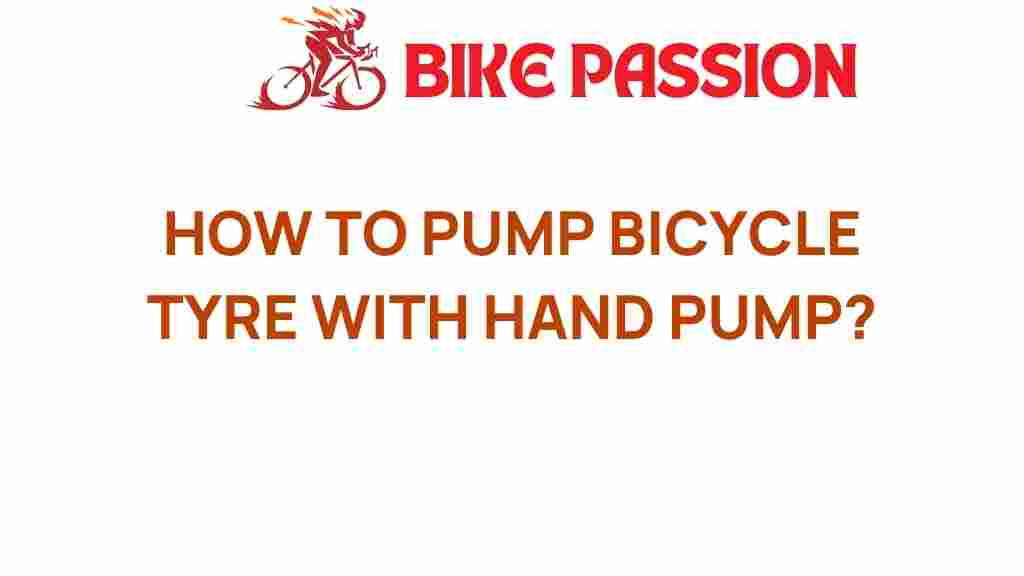Mastering the Art of Pumping Your Bicycle Tyre with a Hand Pump
Riding a bicycle is an exhilarating experience, but maintaining your bicycle’s performance is crucial for a smooth ride. One of the key aspects of cycling maintenance is ensuring that your bicycle tyre is properly inflated. An under-inflated tyre can lead to a host of issues, from poor handling to increased risk of flat tyres. In this guide, we will explore the art of using a hand pump to inflate your bicycle tyre, along with essential cycling tips and DIY cycling gear that every cyclist should have.
Understanding Tyre Pressure
Before we dive into the process of pumping your bicycle tyre, it’s important to understand tyre pressure. Tyre pressure is measured in PSI (pounds per square inch) and can vary based on your bike type and rider weight. Proper tyre pressure contributes to better traction, efficiency, and comfort while cycling.
- Road Bikes: Typically require higher pressure, around 80-130 PSI.
- Mountain Bikes: Usually have lower pressure, around 30-50 PSI.
- Hybrid Bikes: Generally fall in between, around 50-70 PSI.
Always refer to the manufacturer’s recommendations printed on the sidewall of your bicycle tyre for the ideal pressure range.
Why Use a Hand Pump?
While many cyclists opt for electric pumps, a hand pump is an essential tool for cycling maintenance. Here are some benefits of using a hand pump:
- Portability: Hand pumps are lightweight and easy to carry on your bike.
- Reliability: They don’t rely on a power source and can be used anywhere.
- Control: You can feel the pressure as you pump, allowing for precise inflation.
Now, let’s delve into the step-by-step process of using a hand pump to inflate your bicycle tyre.
Step-by-Step Guide to Pumping Your Bicycle Tyre
Step 1: Gather Your Tools
Before you start, make sure you have the following tools ready:
- Your hand pump
- Pressure gauge (optional, but recommended)
- A clean cloth (to wipe any dirt from the valve)
Step 2: Prepare the Bicycle Tyre
Check your bicycle tyre for any visible damage. If there are cuts or bulges, you may need to repair or replace the tyre. If you’re just dealing with low pressure:
- Remove the valve cap from the tyre.
- Clean the valve area with a cloth to ensure a good seal.
Step 3: Attach the Hand Pump
Most hand pumps come with either a Schrader or Presta valve connector. Here’s how to attach your pump:
- For Presta Valves: Unscrew the lock nut on top of the valve and press down to release a little air. Then, attach the pump head and lock it in place.
- For Schrader Valves: Simply press the pump head onto the valve and lock it in place.
Step 4: Inflate the Tyre
Now it’s time to pump! Here’s how to do it effectively:
- Stand with your foot on the base of the pump for stability.
- Use your arms to pump the handle up and down, maintaining a steady rhythm.
- If you’re using a pressure gauge, check the pressure frequently to avoid over-inflation.
Step 5: Remove the Pump
Once you’ve reached the desired pressure:
- Carefully unlock the pump head and pull it away from the valve.
- Quickly replace the valve cap to prevent air from escaping.
Step 6: Check the Tyre Pressure
It’s always a good idea to double-check the pressure after inflation. Use a pressure gauge to ensure it’s within the recommended range. If you don’t have a pressure gauge, you can perform a simple pinch test:
- Pinch the tyre sidewall; if it feels hard and doesn’t easily compress, you’re good to go!
Troubleshooting Common Issues
Even experienced cyclists can face challenges when pumping their bicycle tyre. Here are some common issues and their solutions:
Flat Tyres
If you discover that your tyre is flat despite inflation, follow these steps:
- Inspect the tyre for punctures or foreign objects.
- Check the inner tube for leaks. A simple way to do this is to submerge the tube in water and look for bubbles.
- If you find a puncture, you can use a DIY cycling repair kit to patch it or replace the inner tube.
Air Leakage
If air is escaping when you attach the pump, ensure that the pump head is securely locked onto the valve. If you’re using a Presta valve, make sure the lock nut is loosened before attaching the pump.
Difficulty Pumping
If you find it hard to pump, it may be due to:
- Low-quality pump: Invest in a good quality hand pump.
- Incorrect valve attachment: Make sure the pump is correctly attached to the valve.
Essential Cycling Tips for Maintenance
Maintaining your bicycle is crucial for performance and safety. Here are some additional cycling tips to keep your bike in excellent condition:
- Regular Tyre Checks: Inspect your tyres for wear and tear at least once a month.
- Clean Your Bike: Regularly clean your bike to remove dirt and grime that can wear down components.
- Lubricate the Chain: A well-lubricated chain enhances performance and extends the life of your bike.
- Carry a Repair Kit: Always have a basic repair kit with you for emergencies.
Conclusion
Mastering the art of pumping your bicycle tyre with a hand pump is an essential skill for every cyclist. Not only does it enhance your cycling experience, but it also contributes to safer rides and better performance. Armed with the right knowledge and tools, you can tackle flat tyres and maintain optimal tyre pressure with confidence.
Remember, regular cycling maintenance is key to enjoying your rides. For more cycling gear recommendations and maintenance tips, check out this helpful resource. If you’re looking for quality hand pumps, visit this site for the best deals.
This article is in the category Maintenance and created by BikePassion Team
